PBA Holdings Berhad: The Aberration Named as CSR
Neoh Jia En
Publish date: Fri, 24 Nov 2023, 12:23 PM
- Unlike the concept of corporate social responsibility (CSR), which does not make economic sense, the environmental, social, and governance (ESG) framework presents valid factors that should be incorporated into business and investment decision-making to maximise long-term risk-adjusted financial returns.
-
However, managers who pursue CSR initiatives that reduce investors’ wealth are not necessarily breaching their fiduciary duty towards investors, as some investors might prefer to sacrifice personal wealth for the greater social good.
- The case of the domestic water subsidy by PBA Holdings Berhad – a CSR initiative that directly reduces shareholders’ wealth – could provide valuable insights for managers seeking to understand the preference of Malaysian equity investors.
Amidst the growing adoption of the environmental, social, and governance (ESG) framework by institutional investors and business managers, the overlap between ESG and corporate social responsibility (CSR) initiatives has led to confusion among some market participants. Such confusion might have contributed to anti-ESG movements that erroneously view ESG initiatives as a breach of business and fund managers’ fiduciary duty towards investors. This situation is not helped by the lack of differentiation between ESG and CSR initiatives in disclosures made by many publicly-listed companies in Malaysia.
Considering that both the Securities Commission and Bursa Malaysia are promoting the ESG framework and that the size of ESG-related funds in Malaysia have reached USD 118 billion as at February 2022, it is imperative for all stakeholders to understand the difference between ESG and CSR and their respective relevance. First developed by the United Nations in 2004, the ESG framework encourages investors and business managers to consider risks and opportunities posed by ESG factors for long-term financial returns. On the other hand, CSR refers[1] to the ethical concept that corporates are responsible for their impact on the society, implying that they should operate for the social good.
Given that the purpose of the ESG framework is to maximize long-term risk-adjusted financial returns, it is counterintuitive to claim that ESG initiatives constitute a breach of managers’ fiduciary duty toward investors. The ESG framework helps corporates better prepare for changes in legislation aimed at curbing negative externalities, shifts in consumer behaviours due to greater awareness regarding the social impacts of their products or services, and fluctuations in the availability of supplies due to climate change, among other factors. Similarly, investors who consider the impact of ESG factors on potential investees would make better-informed investment decisions. Therefore, it is arguable that managers who do not consider ESG factors, especially those related to financial risks, in their decision-making are the ones who breach their fiduciary duty, or as Forbes put it aggressively: “If your investment manager told you they were not going to consider risk in managing your investments, because they didn’t think risk was important, you would fire them.”
Contrary to ESG measures, CSR initiatives are not implemented for the benefit of investors and should usually lead to lower financial returns due to the costs incurred. Managers who subscribe to CSR believe that corporates bear responsibilities not only towards investors but also towards other stakeholders in the society; hence, they take actions to reduce negative externalities or increase positive externalities arising from their business operations. The economic concept of trade-off implies that CSR initiatives should reduce investors’ wealth, barring cases where these initiatives coincidentally overlap with ESG measures in the sense that they unexpectedly bring greater-than-cost benefits to investors, such as by reducing the risk of state interventions. Notably, the purpose of CSR initiatives should not lie in financial returns, as rightfully argued by Engel (1979): “a corporate action taken because of management’s belief that it will maximize profits in the long run even if it may damage them this week or this year is not an action of social responsibility…”
However, a negative financial impact of CSR initiatives does not necessarily mean that managers who pursue those initiatives are neglecting their fiduciary duty towards investors. Some investors might prefer to sacrifice personal wealth for social good; therefore, CSR spending is aligned with the interest of these altruistic investors. The existence of such altruistic behaviours has been acknowledged by some economic literature, and economists have been able to reconcile altruism with the utility-maximising behaviour of rational economic agents. Hence, the key question that dutiful managers should ask before spending on CSR initiatives is whether most investors are wealth-maximisers or altruists, and this also determines the relevance of CSR initiatives since the concept of CSR per se is not grounded in economics.
A case study of the preference of Malaysian equity investors
Given the absence of established literature regarding the prevalence of altruism among investors, especially in the context of Malaysia, the case of PBA Holdings Berhad (PBA) could be a valuable reference for managers. Listed on Bursa Malaysia in April 2002, PBA is a Penang state-owned water operator that holds the sole license to supply treated water in the state. With all domestic water consumers in Penang being offered the privilege to subscribe to PBA at RM1.30 per share via the Blue Form allotment during its initial public offering, the stock remained popular among Penangites for quite a few years and was a name that I often heard about when I started my journey of stock speculation in 2005.
Importantly, PBA has heavily subsidised domestic water consumers as its core CSR initiative since corporatisation in 1999. Domestic water tariffs for the first 35,000 litres of monthly consumption are set below the cost of production, resulting in losses that reached RM103.7 million in 2022, nearly four times PBA’s adjusted profit after tax (PAT), as shown in Table 1. This subsidy has likely increased further in 2023 due to a rise in electricity costs in 1H23 and may continue to trend up in 2024 if PBA does not revise its domestic tariffs. Praiseworthily, PBA has labelled the subsidy as a CSR initiative rather an ESG measure, since subsidising domestic consumers does not improve the company’s long-term financial returns.
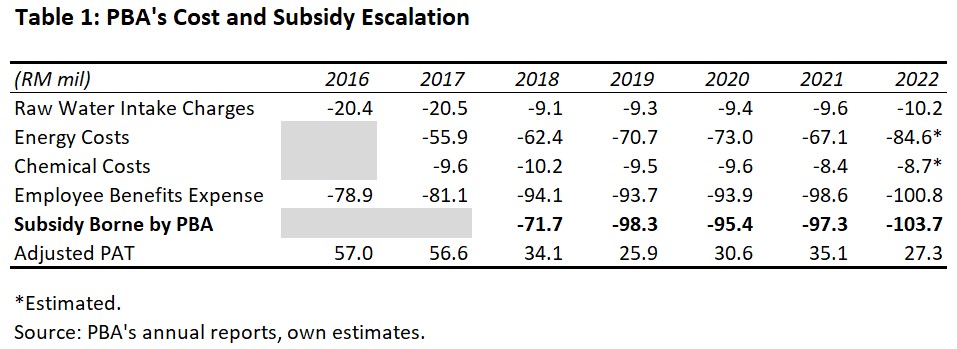
Since the subsidy borne by PBA represents a trade-off between shareholders’ wealth and social good, substantial changes in the level of subsidy could reveal the preference of Malaysian equity investors. If most investors are wealth maximisers, then PBA’s valuation should de-rate with a higher subsidy, and the opposite is true if most investors are altruists. The presence of wealth-maximising investors is supported by the positive relationship between PBA’s price-to-book valuation and return on equity (ROE), as illustrated in Figure 1, while the subsidy is a valid social good since it benefits nearly 600,000 households in Penang, who would be most affected by a hike in water tariffs, as they consume the highest amount of water per capita in Malaysia, as seen in Figure 2.
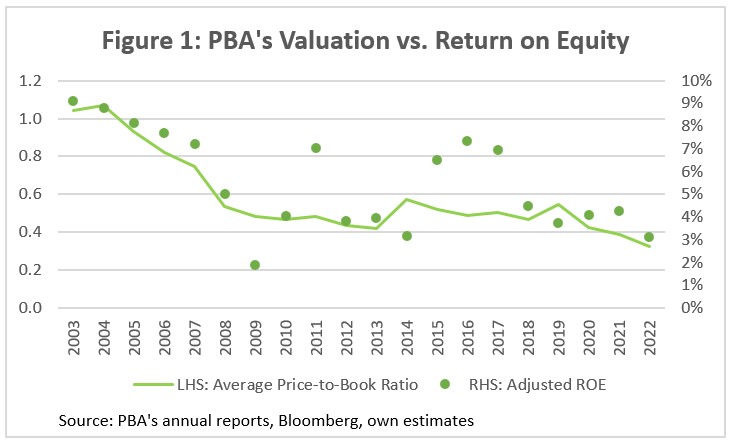
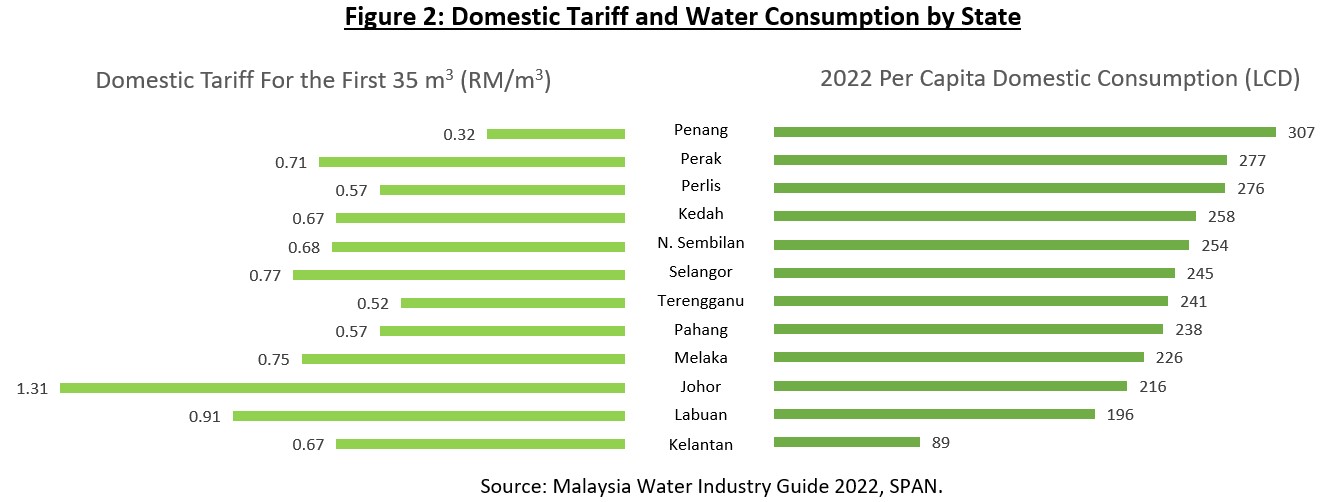
Thus far, the only time when the level of subsidy borne by PBA changed substantially has coincided with trade tariff revisions that also affected financial returns, rendering the event meaningless for understanding the preference of Malaysian investors. Although PBA has been more proactive in applying for tariff revisions since 2009, which could be due to a change in its top management since April 2008 or due to the additional uncertainty in securing tariff hikes that need to be approved by the National Water Services Commission (SPAN) and the Malaysian Cabinet since 2008, there has only been one instance of tariff revisions for domestic water usage below 35,000 litres per month. As seen in Table 2, the subsidy reduction proposed in 2014 was accompanied by a hike in trade tariffs, which also helped to improve PBA’s profit. Since the utility loss suffered by altruistic investors was likely less than the gain made by profit-maximising investors, the re-rating of PBA’s valuation in 2014 is not a good indicator of the preference of Malaysian investors.
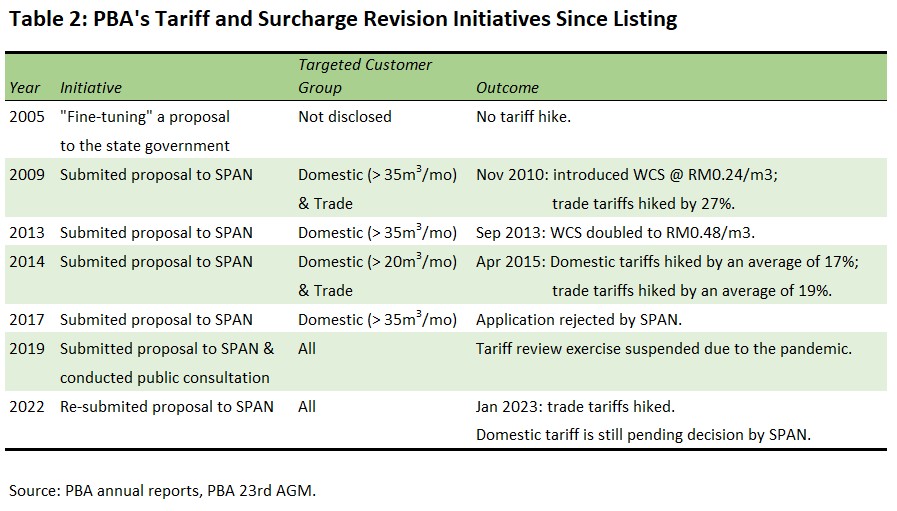
Opportunely, the latest round of water tariff review has split the timing of tariff decisions for domestic users and trade users, meaning that the impact of a potential change in subsidy to PBA’s valuation will not intertwine with the positive impact from the trade tariff revision. While trade tariff hikes have been implemented since January 2023, SPAN’s decision on domestic tariffs is still pending. Management expects additional annual revenue of RM120 million from higher trade tariffs, and their recognition of additional deferred tax assets due to a higher expected[2] utilisation of reinvestment allowance before expiry (85.1% will expire by end-2025) implies that PBA’s annual adjusted PAT could increase to an average of RM79.3 million[3] for the period 2023-25. Since these are public disclosures – coupled with the reported jump in PBA’s 9M23 profit despite a high base in 2Q22[4] and a spike in electricity costs in 1H23[5] – the financial impact from trade tariff hikes has been fully reflected in PBA’s share price, thus paving the way for observing investors’ reaction to a potential revision in domestic tariffs, which will affect the level of subsidy.
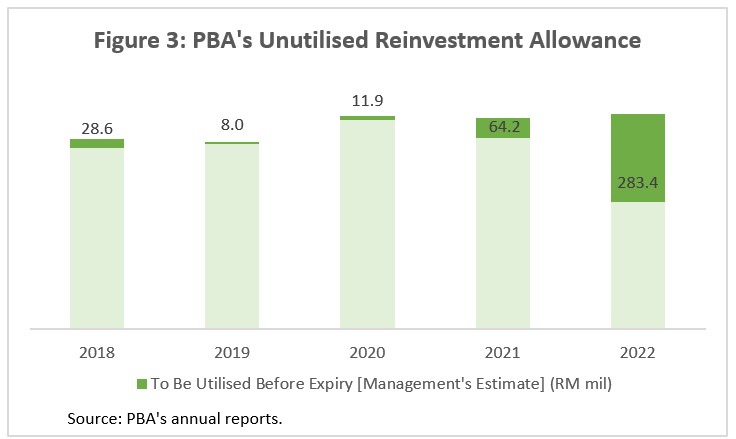
Reassuringly, management’s willingness to scale down the CSR initiative in question is high. After their application for hiking the water conservation surcharge was rejected by SPAN in 2017, management has repeatedly hinted in their discussions in annual reports that the subsidy is no longer financially viable. This is understandable since the state government even had to provide a “put” in the form of not raising their raw water intake fee imposed on PBA back to its original level after halving it in 2018 to partially compensate the company for providing flood relief discounts in November 2017. The situation worsened in early 2020 when PBA judged that there would be an imminent delay in the implementation of Sungai Perak Raw Water Transfer Scheme that was supposed to be financed by the federal government and had to budget for additional capital expenditure (CAPEX) to squeeze existing raw water resources to plug a supply shortfall projected for the period between 2025 and 2030. Considering that PBA has also budgeted for a jump in pipe-replacement CAPEX to fill a two-year backlog, as guided by the management during the company’s AGM on 27th June 2023, the company does have a strong incentive to unwind the subsidy provided to domestic water consumers.
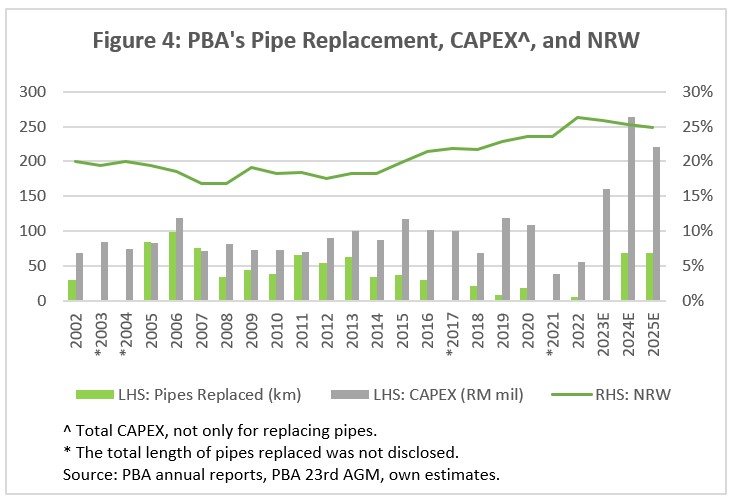
Furthermore, the risk of PBA not being able to secure the federal government’s approval to raise domestic water tariffs is low since the current government, which came into power in November 2022, has been mulling over raising water tariffs at least since May 2023. One likely reason for the delay in approval is that they are looking at ways to alleviate the increased burden on low-income families, which could be facilitated by the implementation of PADU in 1Q24. There is little incentive for the federal government to maintain existing water tariffs by subsidising the electricity bill of water operators while moving away from blanket subsidies.
Importantly, the potential subsidy reduction and its enhancement to PBA’s ROE will likely be significant to render them meaningful in understanding the relevance of CSR, given that the magnitude of tariff hikes is roughly guided, and the event may be accompanied by the introduction of the Imbalance Cost Pass-Through (ICPT) mechanism that allows more frequent tariff revisions in the future. Since 2019, SPAN requires water operators to submit tariff review applications based not only on projected operating expenditure (OPEX) as they did in the past but also on projected CAPEX[6] by referring to the commission’s tariff setting mechanism, as illustrated in Table 3. Considering that the objective of this mechanism is to ensure full-cost recovery for the water industry over the long term, a substantial reduction in subsidy should be expected. Disregarding the jump in PBA’s CAPEX projection post-2020, which means that tariffs should be set even higher, revising domestic tariffs to the rates proposed back in 2019 could halve the amount of subsidy and improve the company’s ROE to low teens from a high single-digit level, based on my back-of-the-envelope calculation. A higher ROE, which might be stabilised by the ICPT mechanism, should attract wealth-maximising investors to PBA, and the much lower subsidy should drive altruistic investors away from the company; therefore, the net impact on the stock’s valuation will provide insights into the preference of Malaysian investors.
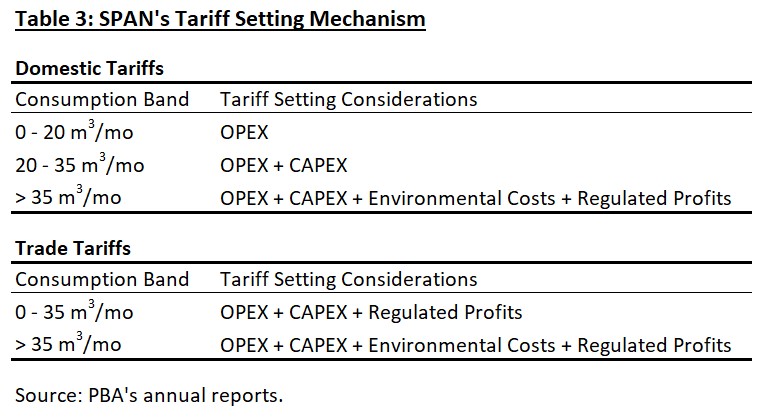
Tuan Nik Nazmi bin Nik Ahmad, 9th November 2023: “Jadi sebab itu tarif kita adalah terlalu rendah. Semua saya tengok kebanyakan kerajaan-kerajaan negeri bersetuju dan kita akan bawa kertas Mekanisme Penetapan Tarif ataupun Tariff Setting Mechanism ini dan juga ICPT untuk air ke Jemaah Menteri sebelum hujung tahun dengan harapan untuk kita benarkan penetapan tarif-tarif baru bagi kerajaan-kerajaan negeri menjelang tahun 2024, tahun baharu ini.”
To sum up, CSR initiatives have the opposite impact on investors' wealth compared to ESG measures. Therefore, managers who wish to fulfil their fiduciary duty towards investors should seek to understand investors’ preferences regarding the trade-off between personal wealth and social good. The impending domestic water tariff hike in Malaysia provides a unique opportunity to do so, as managers could observe investors’ reactions to a potential scaling-down of the core CSR initiative by PBA. If PBA’s valuation re-rates upon the domestic tariff hike, then there is no rationale for managers to commit to CSR initiatives; conversely, if PBA’s valuation de-rates upon the event, then managers should spend more on CSR or even consider converting their companies to non-profit organisations.
Endnotes:
[1] The European Commission defines CSR as “the responsibility of enterprises for their impact on society,” while the CFA Institute, in its official training manual for the Certificate in ESG Investing, defines CSR as “a broad business concept that describes a company’s commitment to conducting its business in an ethical way.”
[2] Since the recognition of deferred tax assets, which was substantial in 2022, required management’s judgement, the external auditor has highlighted it as a key audit matter and “evaluated the appropriateness of estimates and key assumptions used by the Group in determining the profit forecast…”
[3] Considering the provisions in IAS 12/MFRS 112, and assuming that (1) PBA’s profit or loss from non-water subsidiaries is negligible; (2) all reinvestment allowance amounting to RM 103.8 million that expires in 2031 will be utilised in 2026-31, leaving only RM179.5 million to be used to offset 70% of PBA’s statutory income in 2023-25; (3) PBA has no non-taxable income or non-tax-deductible expenses; and (4) adjusted PAT excludes tax income from recognising deferred tax assets and includes cash savings when those tax assets are utilised to reduce tax expenses.
[4] Penang water consumption spiked to 945 million litres per day (MLD) in May 2022 post-reopening and moderated to 868 MLD for the full year.
[5] The increase in electricity surcharge from 3.7 cents/kWh in 2022 to 20 cents/kWh in 1H23 might have led to an additional RM20m in energy costs for PBA during the period, although this increase in surcharge was reversed for all water operators since 3Q23.
[6] SPAN’s previous discussion regarding its tariff setting mechanism confirmed that the magnitude of tariff hikes could be affected by CAPEX projections: “Bagi mengurangkan impak drastik yang dijangka kepada pengguna dari segi kemampuan dengan pelaksanaan TSM penuh, adalah dicadangkan supaya TSM dilaksanakan secara berperingkat atau separa untuk mengehadkan sebarang kenaikan tarif pada 30%. Sehubungan ini, kenaikan tarif yang melebihi 30% hanya dibenarkan untuk Pahang dan Perlis yang tidak menyemak tarifnya melebihi 20 tahun sehingga menyebabkan defisit operasi yang tinggi. Di samping itu, Pulau Pinang juga dibenarkan untuk kenaikan tarif yang melebihi 30% bagi membolehkan operator negerinya menampung keperluan perbelanjaan modal masa depan.”
Sanity Check on PBA's ROE (with circular reference): https://docs.google.com/spreadsheets/d/1OZZIHIO4XgBFjd9CKqi6koj88QCAa3Wi/edit?usp=drive_link&ouid=115125308278906410638&rtpof=true&sd=true
Sanity Check on PBA's ROE (hard coded): https://docs.google.com/spreadsheets/d/10aTv66LpAPTC8BtezQ8kgBai_YqkYaV8/edit?usp=drive_link&ouid=115125308278906410638&rtpof=true&sd=true
Sanity Check on PBA's ROE (with circular reference, updated 17/1/2024): https://docs.google.com/spreadsheets/d/1OkStglLccQZsJFvkm95y_e3jyYZTWd7p/edit?usp=drive_link&ouid=115125308278906410638&rtpof=true&sd=true
Sanity Check on PBA's ROE (hard coded, updated 17/1/2024): https://docs.google.com/spreadsheets/d/1OM43OnofiZuRf32CKgOy25fkzICduF_G/edit?usp=drive_link&ouid=115125308278906410638&rtpof=true&sd=true
P.S.: For wealth-maximising investors: PBA provided each shareholder who registered for its online AGM in June 2023 with RM50 in cash as a door gift.
P.P.S.: Some investors seem to have misunderstood the accounting for deferred tax assets that arise from reinvestment allowances (RA). When PBA incurs qualifying CAPEX and expects to generate enough future profit to utilise the RA (i.e., to offset 70% of statutory income and reduce cash tax expenses) before its expiry (paragraph 24 of IAS 12/MFRS 112), the company recognises the unutilised RA as a deferred tax asset and records a tax income immediately (although I removed this income from adjusted PAT). Subsequently, when the deferred tax asset/unutilised RA is actually utilised, PBA's profit will not be boosted (although I added this saving to adjusted PAT), else there will be double counting since the same RA has already been recorded as a tax income previously. PBA's volatile tax income/expenses stems from the fact that the company has RM591.6 mil worth of unutilised RA accumulated between 2000-2018 and expiring end 2025 which is not likely to be fully utilised (thus could not be entirely recognised as deferred tax assets) due to insufficient profits. Whenever PBA updates its internally projected future profits (in this case, cumulative profits until 2025), it has to update the amount of RA expected to be utilised and of deferred tax assets and recognise a tax income or expense accordingly, hence the volatility. However, this also means that we could roughly derive the management's profit estimates from the amount of expected utilisation of RA disclosed in PBA's quarterly and annual reports.
More articles on Lorem ipsum
Created by Neoh Jia En | Feb 02, 2024
Created by Neoh Jia En | May 29, 2023
Created by Neoh Jia En | Feb 10, 2023
Created by Neoh Jia En | Dec 30, 2022
Discussions
PBA Fair Value based on 3 scenarios:
BEAR: Fair Value (FV) = RM1.75
Neutral: FV = RM2.80
BULL: FV = RM3.50
FY23 = RM92m or EPS = 27.8 sen
FY24 = RM115m or EPS = 34.7 sen
FY25 = RM118m or EPS = 35.6 sen
Now already November 2023, so FY24 EPS is more relevant.
FY24 EPS = 34.7 sen
Scenarios:
1. Bearish Scenario (Recession coming, electronics company all leaving Penang)
I will use 5x PE which is usually used for distressed economy or company.
5 times 34.7 sen = 173.5 sen (RM1.75 for easy reference)
2. Base Case Scenario (Malaysia GDP still grow 3%-5%, no recession, electronics/industries company still expand and use more water every year)
I will use 8x PE which is usually used for normal time, no recession.
8 times 34.7 sen = 277.6 sen (RM2.80 for easy reference)
3. Bullish Case Scenario (Malaysia GDP still grow 5%-6%, US achieved soft landing, Penang electronics/industries company expand a lot and use much more water every year)
I will use 10x PE which is usually used for good time. It is not excessive when market is bullish.
10 times 34.7 sen = 347 sen (RM3.50 for easy reference)
I am using his model and divide the earnings forecast with number of shares to get EPS.
Source:
https://docs.google.com/spreadsheets/d/10aTv66LpAPTC8BtezQ8kgBai_YqkYaV8/edit?usp=drive_link&ouid=115125308278906410638&rtpof=true&sd=true
2023-11-24 20:06






















ValueInv888
PBA = hidden gem!
2023-11-24 17:22